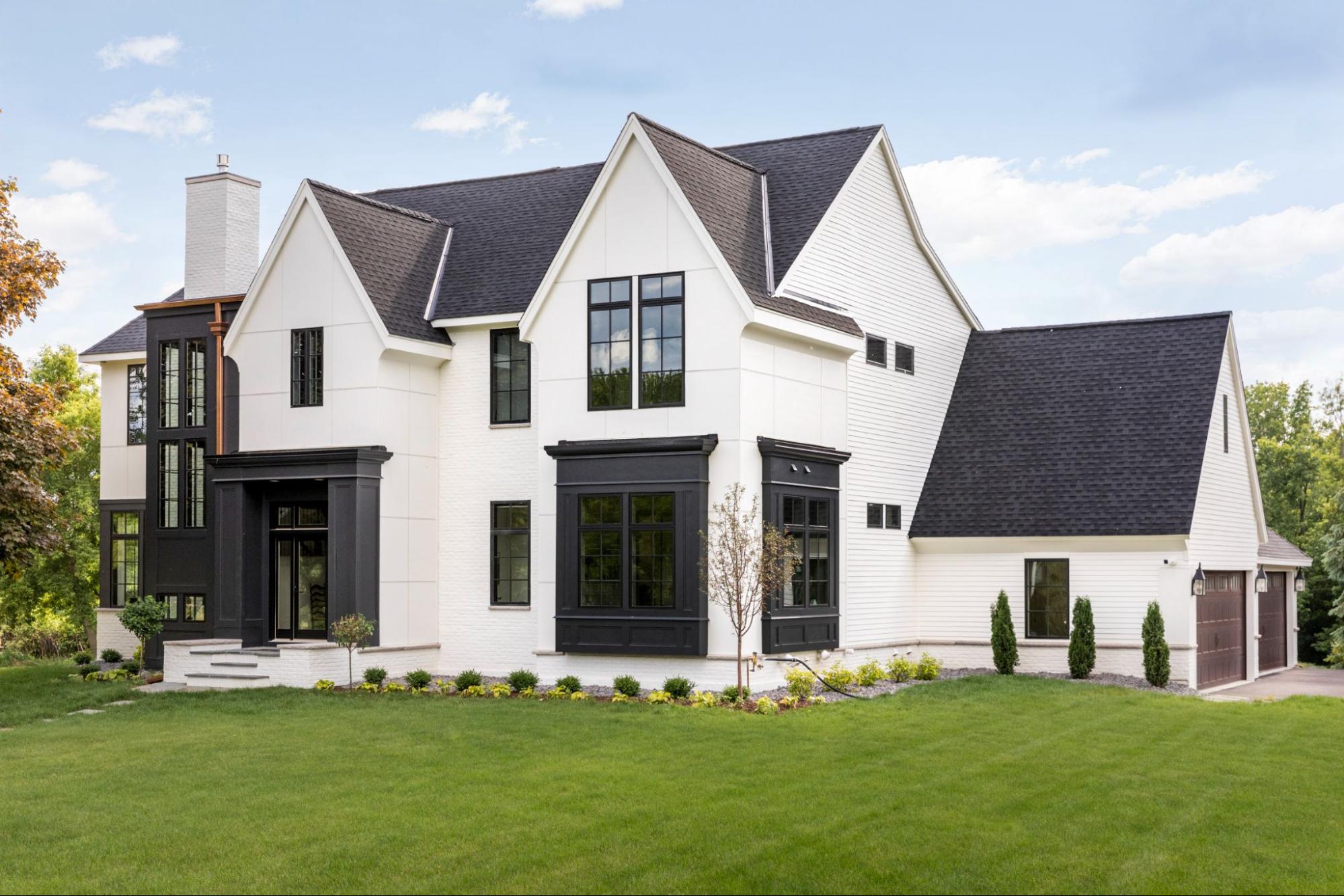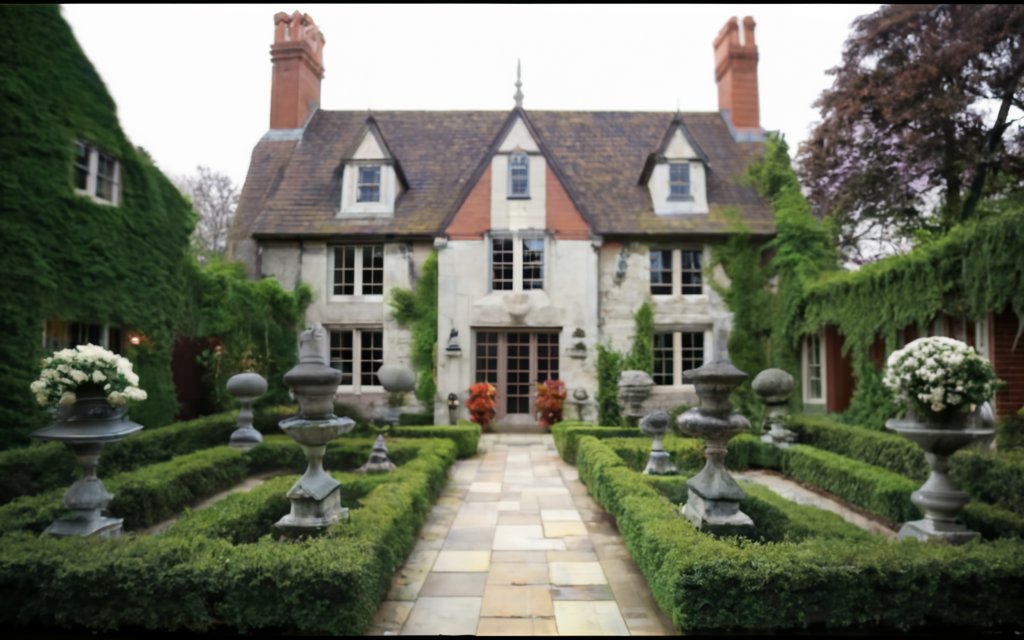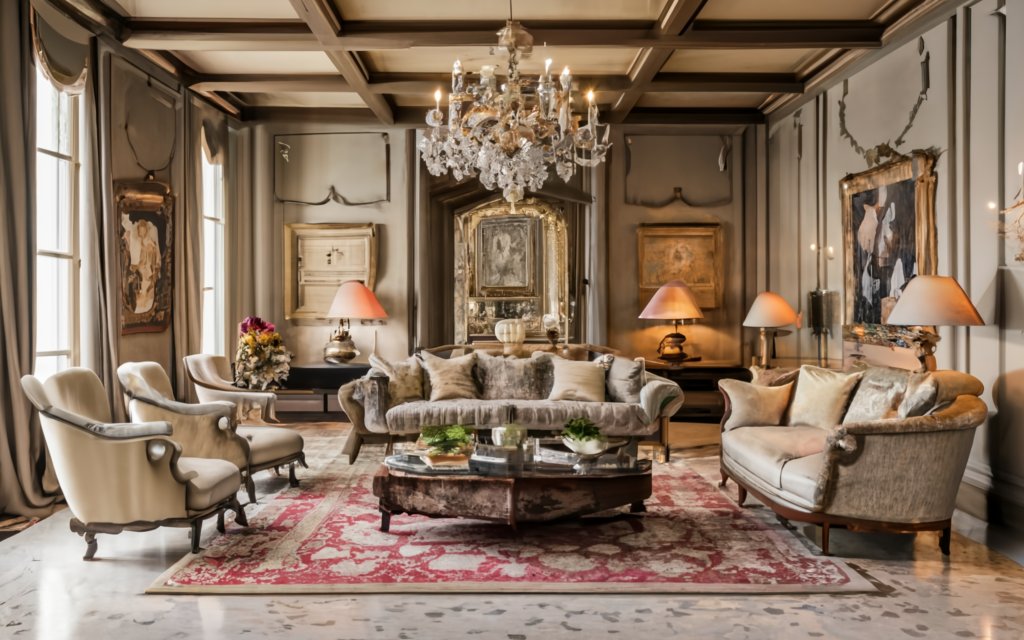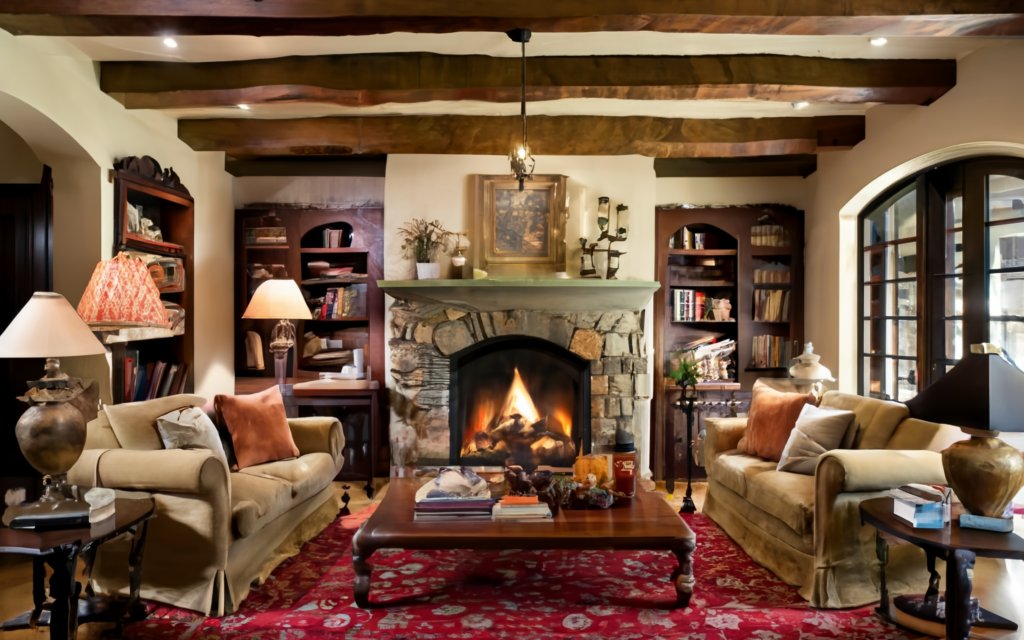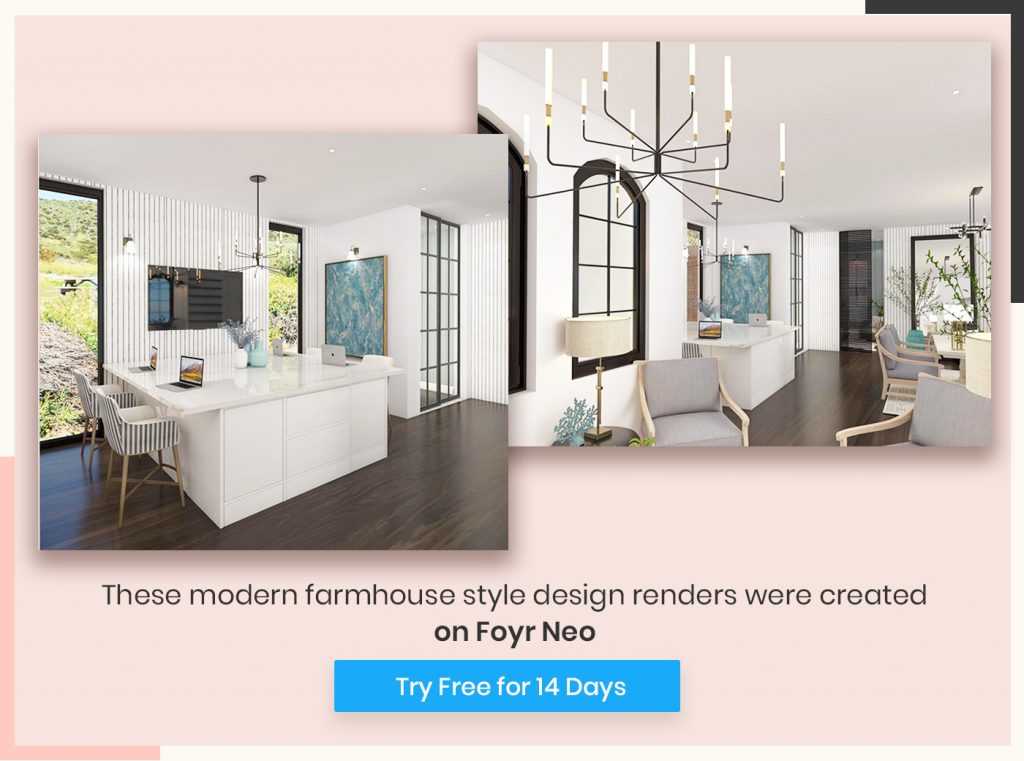Table of Contents
If your client has bought a lovely piece of land in the country, blanketed by greenery, and wants to build a dream home that’ll stand the test of time, and be an iconic statement in itself, you should consider making a Tudor-style home.
If you’ve read or watched the Bridgerton series, or novels or are smitten with the glorious look of the English mansions and palaces, you know how royal these palaces can be. What if we told you you can create the same magical living space for your clients, regardless of whether it’s a small area or a massive estate?
Tudor-style homes are in vogue, and the customization options you can harness are unlimited, so why wait? We’ve handpicked the best decor ideas for a Tudor-home so you can get your hands on this August piece of architecture and bring it to life for your clients today.
Legacy of Tudor-Style Houses
Tudor architecture is popular and easily recognizable even today, despite being a marvel of old-world architecture. It’s a 20th-century style that stuck to people’s hearts long after it went out of fashion, and had a Tudor revival in the past few decades.
During the reign of Henry VIII, and Elizabeth I, English domestic architecture and interior decorations bloomed. The economy flourished and people ventured to build creative, more sophisticated homes in tune with their surroundings and their preferences, thus came Tudor-style houses.
They rose in popularity in the 19th century, long after the Tudor period and gradually spread to former British colonies. Inspired by English architecture of the medieval period, these houses are creative endeavors to recreate the English country life in your client’s home. Modern Tudor-style houses can be built in any space and cater to any taste, ranging from small little cottages to suburban homes to stately mansions. Although the enthusiasm towards these houses has been on and off, it’s known that they’re a beloved historic home style, especially in English and American landscapes.
Read also – How to Create the Best Architect Portfolio in 2024
Key Characteristics of Tudor Houses
- Their range and versatility to fit into any space
- Conventionally, they’re one or two storied, with an overhanging second-story
- Built with natural materials predominantly – brickwork, stone, or stucco exteriors
- Have half-timbered walls with wooden beams that are often stained or painted in dark wooden tones to mimic the naturally aged trees around the house
- With multiple front-facing gables and eaves adorning the house, they have irregular floor plans that fit together like a jigsaw puzzle
- Often found with tall, multi-pane, bay windows made of glass and diamond-shaped panes
- Signature 2-door pointed arches atop doorways and windows, steeply pitched roofs, cross gables, shingled roofs with large-scale stone or brick chimneys
Pros and Cons of Tudor Style Houses – Should You Go For Them?
|
Pros |
Cons |
| ✅ Unique charm and has a whimsical look, making it an ideal style for dream houses | ❌ Large open-concept floor plans or such niche requirements might be hard to fit in this style |
| ✅ Super versatile capabilities to be customized to any extent | ❌ The need for several, heavy drapes can take a toll on energy efficiency |
| ✅ Natural materials used throughout the home design are highly durable and make for a great family home for generations | ❌ Since it’s a niche style, it may not be preferred by home buyers, if you’re ever looking to sell the house |
| ✅ Creates a cozy, inviting atmosphere | ❌ Needs high maintenance |
| ✅ Rooflines make for ample attic and living space that can be used for different purposes | ❌ Future remodels or renovations can be expensive |
How Do You Design a Tudor Home?
Like other homes, these houses don’t come as a blank slate. The exterior theme trickles down to the interiors, and you have to make sure you adapt the interior decor to the storybook Tudor-house style.
Tudor-Style Exterior Design Essentials
The first impression of the exterior makes you fall in love with the home. That’s why we’ve lined up exterior decor ideas for you.
Siding Materials and Exterior Color Palette
Decorative half timbering popping against stucco clad exteriors – that’s mostly how a builder would visualize this type of house. Use siding materials like brick exterior, stone, cedar, shingles etc to do justice to the archetypical style. For the exterior color palette, your choices are wide open, ranging from brown, tan, mahogany and the like. Warm, wooden tones work best. Celebrate the rusticity of the architectural style, and design facades in warm timber framing, stone, brick – materials that add texture, character and contrast to any structural additions.
Read also – How to Choose the Right Doorknob/Door Handle for Your Design?
Front Door
The front door steals guests’ hearts even before they enter the home. Make it an attractive feature. Go bold and design stained, quarter-sown, glazed Oak doors that create a quintessential Tudor-style home look. Go for a castle-like plank or paneling on the front door that’s trimmed in stone work or protected by a small gabled roof.
Dormers and Windows
Opt for narrow casement windows with small geometric panes and leaded glass designs, to give a complete Tudor-style house look.
Brick Chimneys
Substantial brick chimneys are hallmarks of the style, and should be given utmost importance in design and construction.
Gardens and lanscaping
Design ivy-covered facades, and bring in lots of greenery in the garden. Go for rosh bushes, fresh herb gardens, delphiniciums, box hedging and install large planters to give an authentic English country-home vibe.
| Richard Ouellette, Head Design and co-owner at Les Ensembliers says, “This type of house generally has quite dark tone and has a lot of connection issues between rooms. The real challenge is making it into a home that feels cozy with great connections, while retaining the character and keeping it open.” |
Tudor-Style Interior Design Ideas
Now that we’ve covered the exterior decor, let’s move in. Lots of nuanced interior decor ideas for you.
Interior Color Palette
Traditional English color palette takes inspiration from the natural surroundings, and builds on it with chalky neutrals, off-white, ochre, neutral woods, torp and country greys. They are complemented by forest and khaki greens, muted yellows, oranges, reds, soft blues, and faded pinks in all decor pieces. For depth and contrast, go with deep brown, mahogany, along with warm brass, bronze and navy blues.
Wall Decor
Tudor-style houses have plenty of warm colors splashed around, so your best bet is to accent them with light, warm colors without disturbing the harmony of the warm tones. Stick to the sparing use of cool colors. Mossy-colored cabinets with green, earthy undertones are a fine pick. Wallpaper is a fine choice of wall decor. Use the titular pattern generously – Tudor roses of England that come in different colors and styles.
Read also – 28 Best Wall Decor Ideas To Decorate Your Blank Wall
Beams and tresses
Exposed ceiling beams are an iconic feature of these houses. Not only are they aesthetic, they hide electrical wires and help mount sconces and such electrical fixtures easily. Install exposed beams on the ceilings of doorways, kitchens, entryway, hallways etc, and choose amongst European walnut, mahogany, Russian Deal, English Oak, Elm and Chestnut wood.
Wainscoting
Frame parts of your client’s home and ceiling to give a lived-in feeling. Cornicing wooden carvings, dedo, picture rails, pillars and large sash windows are some of the ways you can use wainscoting in a English Tudor-style home.
Furniture
The wood you use in furniture need not be all real wood. Faux wood stained to match the color palette of the house suits well. Rich timber and opulent fabric will make a royal statement. To make this happen, you need to choose wooden furniture whose pattern is different than your wall trims.
Suggest a heavy-Oak furniture item, like the four poster bed with a canopy on top – a staple in Tudor design. It may be a big investment, but it’ll serve your client for ages to come. Wrought iron is a god-send for these houses. Use them handsomely – as hardware for kitchen cabinets, lamp bases, tables etc.
Mahogany, walnut, cherry, rosewood, stripped and natural and painted timbers are casual everyday items you can see in the Tudor-style house. Bring in furniture made of these materials and you’ll be overwhelmed with delight at the opulence the house exudes.
- Get a Mahogany dining table framed with chip and dale or high backed wooden dining chairs with fabric seats.
- Get dark wood bureaus, hall tables and bedroom chests.
- For conversational areas in the living room, get tufted chesterfield slip covered, or rolled arm sofas, mixed upholstered, and slip covered chairs with exposed legs.
- Tufted and upholstered ottomans that serve as coffee tables, side tables and foot stools.
- For mudrooms get designated pigeon holes, bench seating and open shelving
- Layer sofas, armchairs, window seats and beds with cushions and throw pillows
For upholsteries, pick out hopsack, silk, velvet, linen, wool, jute and rattan to get the desired finish. Crank up your design game up a notch by including immaculate details in the upholsteries. Choose these patterns in your upholsteries and hyper-personalize the design – traditional prints of gingham, plaid, ticking stripe, chintz, floral damask, suzani and twill patterns.
Read also – 10 Furniture Styles & Trends That You Can’t Afford to Miss in 2024
Artwork
Gallery walls are iconic in Tudor-style homes. Install photos of family’s memorable moments, or historical moments, equine sports or the surrounding landscape. On the other hand, you could also hang up large, old, oil paintings, animal sketches or paintings of animals that hail from the region. These pieces of artwork will sit below the picture lights. Use plenty of mirrors wherever possible, with royal framing and in traditional shapes.
| Richard Ouellette, Head Design and co-owner at Les Ensembliers says, “A great challenge while designing Tudor-style homes is that each client has their own personality, collections and things they have lived with for years. You shouldn’t take away the personality, rather you should emphasize it.” |
Window Treatment
Blur the lines between the indoors and outdoors, but take the liberty to play around with colors and patterns for the windows. Stained glass windows pose a fitting material for the classic-inspired dining room. Curtains and blinds are opportunities for you to add color, pattern, and visual texture in otherwise, plain windows. Typically, for these houses, designers and craftsman choose heavy lined drapes, floor skirting curtains, Roman and festoon blinks in addition to the marvelous drapes.
Flooring
Dark wood flooring is best for these homes, as they offset the height of the ceiling, and make the place feel not too cold or hot – just the right ambiance for an intimate gathering. For the entire house, if your client isn’t hell bent on a particular type of flooring, best to go with parquet or simple tongue and groove flooring in living and dining spaces. For kitchens however, bring in irregular flagstone tiles, or limestone, or checkerboard, or black and white marble flooring.
Read also – How Interior Designers Choose Flooring for Interiors
Drapes and Tapesteries
Rich, elaborate drapes complement the natural ambiance of the Tudor style house. Go for softer, romantic colors and materials for a cozy feeling. Double down on tapestries. Use them as decorative frames and hang them on walls, or stairwell for a traditional look.
Rugs of all types work well with the Tudor-style house, however there are showstoppers who have won hearts all over the world – Persian, Aubusson, Anatolian, Suzani rugs and kilns. For materials, however your go-tos are natural fibres like jute and sisal.
Accessories
The most commonly found accessories in the Tudor-style homes are brick a bracs, hand painted cups and saucers, painted pottery, plates, vases, chinoiserie, animal figurines, mantle clocks etc.
| Richard Ouellette, Head Design and co-owner at Les Ensembliers says, “There’s something about the way that each room in the Tudor-home has its own personality. They don’t necessarily blend together, but when you walk through the house, there’s a great cohesive feel to the home. You want to make sure each room has really great and strong statements along with a flow to the entire space.” |
Lighting
English homes are lit adequately, and devoid of harsh lighting of any sort.
| Area | Type of lighting to be used |
| Ceilings |
|
| Formal living and dining |
|
| Mantels, hallways and kitchen shelving |
|
| Areas where artwork is hung |
|
| Sidetables, desks, bedside tables and reading nooks |
|
The lamps you use for lighting need to be made of materials that agree with the Tudor-style. That’s why we advise you to stick to wood, iron, aged brass, bronze, antique silver and porcelain for lamp bases.
Take the design up a notch by having trophy, urn, corinthian column style bases made out of the above materials. For a softer glow and texture, get pleated, gathered or drum lamp shades made out of linen, silk or velvet, depending on the budget, and bring in decorative floral motifs in them.
Read also – The Importance of Lighting in Interior Design
Fireplace
One of the most iconic spots in a Tudor-style house is the open-log fireplace. Decorate the mantle with vases filled with fresh flowers, books, family heirlooms or memorable photos. The wall surrounding the fireplace mantle can be used for open shelving and books can be stacked to make a great impression on the house guests. Ornate stone or marble hearths add an element of grandeur to the interiors.
Family rooms with libraries are typical of homes in England. Create a cozy conversation or reading nook in front of the fireplace and your client will feel grateful for it for years to come.
Kitchen
- Go ahead with a beaded inset for the cabinetry doors
- Use complementary, yet bold colored and textured hardware throughout the kitchen
- Go for wooden, or wood stained kitchen islands and adorn the surface with brass and golden tones for plumbing accessories
- Get an Alcove hood range and create niches in the hood to place items while cooking
- Go for chalky matte finishes
- Ceramic apron front sinks are best to complete kitchen look
Read also – 15 Best Kitchen Design Tools And Software To Use In 2024 (Free & Paid)
Bedroom
For the bedroom, design a walk-in or walk-through closet for a palatial look. Go for chippendale style poster beds made of Mahogany, painted timber and aged brass. To pique interest, opt for a return headboard with ornately carved wooden frames or a bespoke upholstered headroom with beautiful English fabrics.
Tudor-Style Houses From the Designers’ Desks
Want to see real Tudor-style houses some of the seasoned designers designed? Here you go.
1. Modern Tudor designed by Bria Hammel, CEO & Creative Director of Bria Hammel Interiors
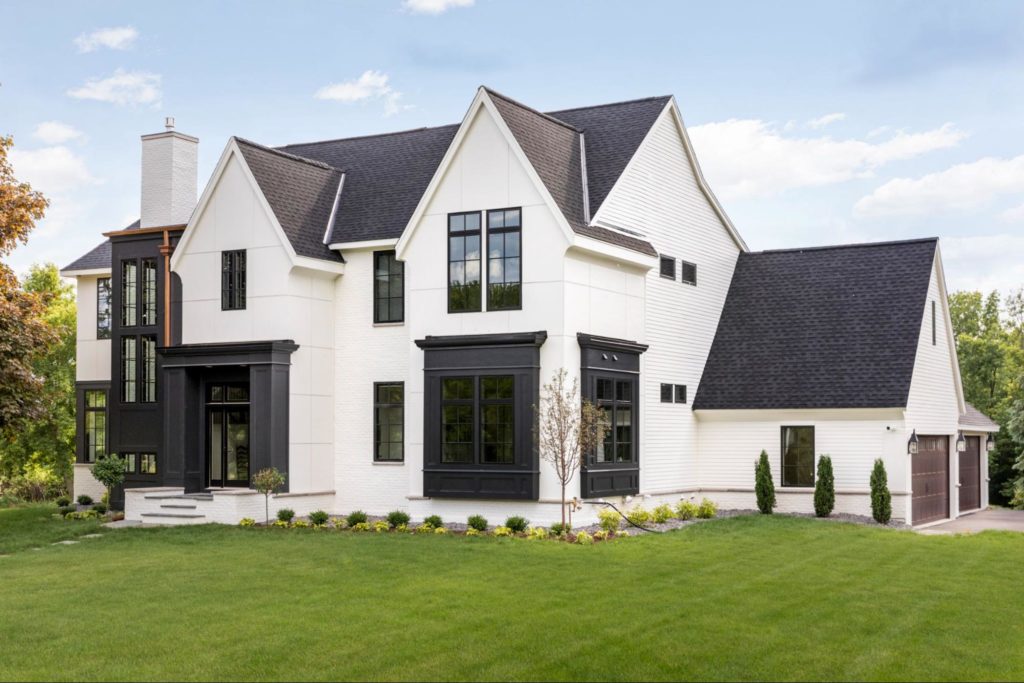
The infusion of modern elements into the classic Tudor style, complemented by a pristine white exterior, creates a striking visual impact that is both timeless and contemporary. The use of copper gutters adds a touch of sophistication, providing a warm contrast against the white facade. As an interior designer, this presents an exciting opportunity to extend the modern aesthetic inside, creating spaces that seamlessly blend functionality with a clean, crisp design.
Read also – 27 Hidden Door Ideas That Make You Want to Build a Secret Room Today
2. Dahlia Tudor Style Bungalow, designed by Karan and Sapna Aggarwal
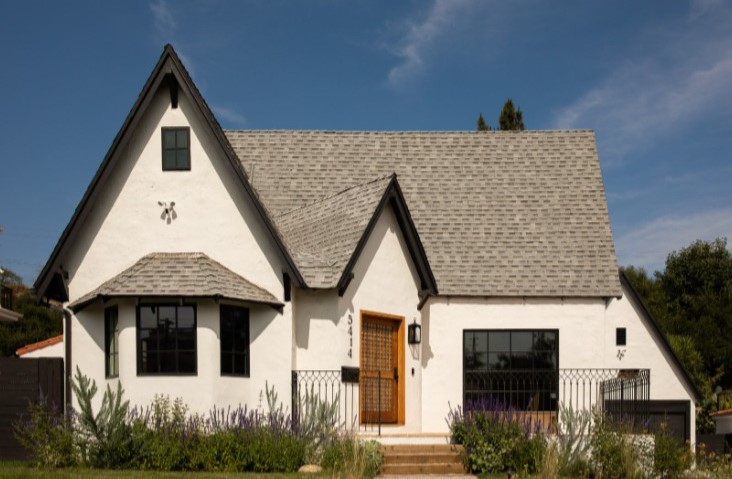
The Dahlia Tudor style, with its charming architectural features, brings a timeless allure to the bungalow setting, creating a home that is both distinctive and welcoming. The fresh Dahlia Tudor bungalow serves as a versatile canvas, allowing for the infusion of contemporary furnishings, dynamic colour palettes, and personalised decor. This seamless blend of historic charm and modern elegance makes it an ideal choice for those desiring a home that embodies a unique, timeless style.
Design Photogenic Tudor-style houses with Foyr Neo
Given that your Tudor home’s floor plan is unique, how do you know which of the above decor items will work in your space and which won’t? You figure it out by visualizing the Tudor-style home with your favorite items and ruling out the ones that don’t fit in.
How can you visualize every inch of the space without leaving anything to chance? With an advanced tool like Foyr Neo.
Here’s what you can do:
Step 1: Sign up for Foyr Neo’s 14-day trial.
Step 2: Go on to the Neo mood board and curate everything you’d love to have in the Tudor home.
Step 3: Create the floor plan of the space on Neo.
Step 4: Choose from 60,000+ 3D decor materials and simply drag and drop them into the interior design.
Step 5: Get any material in any color scheme, texture, shape, or pattern and truly customize your Tudor style home.
Step 6: View the makeover in 2D and 3D, from all possible angles and lighting conditions.
Step 7: Render your design in a few minutes and witness your Tudor home in all its glory.
That’s all it takes! With 24/7 support and live chat, we’re here to help you if you ever get stuck anywhere. You can find tutorials on how to design on Neo all over the internet, so you’re never truly alone when you design using Neo.
What are you waiting for? Start curating your mood board for your dream Tudor-style house. Sign up for Foyr Neo’s 14-day free trial today.
FAQs
Darkening the beams and using contrasting paint colors or wallpaper on the ceiling.
Hardwood floors or stone tiles can enhance the authenticity, while rich carpets add warmth and comfort.
Use consistent color palettes and design elements while adapting furnishings to suit the specific function of each room.
Yes, by carefully selecting elements that harmonize, such as neutral tones or natural materials.
Opt for vintage-style fixtures, pedestal sinks, and finishes like brass or oil-rubbed bronze.








